Blending hibiscus and hawthorn creates a powerful duo for heart health. You'll benefit from hibiscus's ability to lower blood pressure and reduce bad cholesterol, while hawthorn strengthens your heart muscle and improves blood flow. Together, they enhance circulation and combat inflammation in your blood vessels. These herbs are rich in antioxidants, protecting your heart from oxidative stress and cellular damage. Their synergistic effects offer natural support for managing hypertension and maintaining healthy cholesterol levels. By incorporating this herbal combination into your daily routine, you're taking a holistic approach to cardiovascular wellness. Discover how these two plants can revolutionize your heart health regimen.
Understanding Hibiscus and Hawthorn

Nature's pharmacy offers two powerful allies for heart health: hibiscus and hawthorn. These botanical wonders have been used for centuries in traditional medicine, and modern research is now backing up their cardiovascular benefits.
Hibiscus, a vibrant flowering plant, is renowned for its tart flavor and deep red color. It's rich in antioxidants, particularly anthocyanins, which help protect your blood vessels from damage. Studies have shown that hibiscus can help lower blood pressure and reduce bad cholesterol levels.
Hawthorn, a small tree or shrub, has been a staple in heart health remedies for thousands of years. Its berries, leaves, and flowers contain potent compounds that can improve heart function.
Hawthorn has been found to increase the heart's pumping ability, widen blood vessels, and reduce symptoms of heart failure.
When you combine these two botanical powerhouses, you're tapping into a synergistic effect. Hibiscus tackles blood pressure and cholesterol, while hawthorn strengthens the heart muscle and improves circulation.
Together, they create a thorough approach to supporting your cardiovascular system, offering a natural way to nurture your heart health.
Heart Health Benefits

You'll find that hibiscus and hawthorn offer significant heart health benefits.
These herbs can improve your cardiovascular function and help lower your blood pressure.
Additionally, they're rich in antioxidants, providing protection against oxidative stress and supporting overall heart health.
Improved Cardiovascular Function
Both hibiscus and hawthorn offer significant benefits for cardiovascular health. When combined, they can work synergistically to improve your overall cardiovascular function.
Hibiscus has been shown to help lower blood pressure, reducing strain on your heart and blood vessels. It may also help decrease LDL cholesterol levels, which can contribute to plaque buildup in your arteries.
Hawthorn, on the other hand, is known for its ability to strengthen the heart muscle and improve blood flow. It can help dilate blood vessels, making it easier for your heart to pump blood throughout your body. This herb may also help regulate heart rhythm and reduce the risk of arrhythmias.
Together, hibiscus and hawthorn can provide extensive support for your cardiovascular system. They may help improve circulation, reduce inflammation in blood vessels, and support the overall health of your heart.
By incorporating this powerful blend into your routine, you're taking proactive steps to maintain a healthy heart and reduce your risk of cardiovascular diseases.
Remember to consult with your healthcare provider before adding any new supplements to your regimen, especially if you have existing heart conditions or are taking medications.
Lower Blood Pressure
One of the most notable heart health benefits of hibiscus and hawthorn is their ability to lower blood pressure. These two powerful herbs work synergistically to reduce hypertension, a major risk factor for heart disease and stroke. Hibiscus contains anthocyanins and other antioxidants that help relax blood vessels, while hawthorn improves blood flow and strengthens the heart muscle.
Studies have shown that regular consumption of hibiscus tea can considerably lower both systolic and diastolic blood pressure. Hawthorn, on the other hand, has been used for centuries in traditional medicine to treat various cardiovascular issues. When combined, they offer a natural and effective approach to managing blood pressure.
| Herb | Active Compounds | Blood Pressure Effects |
|---|---|---|
| Hibiscus | Anthocyanins | Relaxes blood vessels |
| Polyphenols | Reduces inflammation | |
| Hawthorn | Flavonoids | Improves blood flow |
| Oligomeric procyanidins | Strengthens heart muscle | |
| Triterpenes | Helps regulate blood pressure levels |
Antioxidant-Rich Protection
Hibiscus and hawthorn offer a powerful antioxidant punch that's essential for heart health. These plants are rich in polyphenols, flavonoids, and other compounds that protect your heart from oxidative stress and inflammation. Antioxidants neutralize harmful free radicals, which can damage cell membranes and DNA, leading to cardiovascular problems.
When you consume hibiscus, you're getting a dose of anthocyanins, which give the plant its vibrant color and provide potent antioxidant effects. These compounds help reduce LDL cholesterol oxidation, a key factor in atherosclerosis development.
Hawthorn, on the other hand, is packed with proanthocyanidins and flavonoids that improve blood flow and strengthen blood vessel walls.
Together, hibiscus and hawthorn create a synergistic effect, enhancing each other's antioxidant properties. This combination can help prevent the formation of plaque in your arteries, reduce inflammation, and protect your heart from age-related damage.
Synergistic Effects

Nature's wisdom shines through in the synergistic effects of hibiscus and hawthorn when combined for heart health. These two plants work together to enhance each other's beneficial properties, creating a powerful alliance for cardiovascular well-being.
When you blend hibiscus and hawthorn, you're tapping into a synergy that amplifies their individual benefits. Hibiscus helps lower blood pressure and reduces bad cholesterol, while hawthorn improves blood flow and strengthens the heart muscle. Together, they create a more potent effect on overall heart health than either would alone.
This combination also supports your body's antioxidant defenses more effectively. Hibiscus contributes anthocyanins and vitamin C, while hawthorn adds flavonoids and procyanidins. These antioxidants work in concert to neutralize harmful free radicals and reduce oxidative stress on your cardiovascular system.
Moreover, the blend can help regulate heart rhythm and improve the efficiency of your heart's contractions. You'll benefit from improved circulation, reduced risk of blood clots, and better overall cardiovascular function.
Antioxidant Power
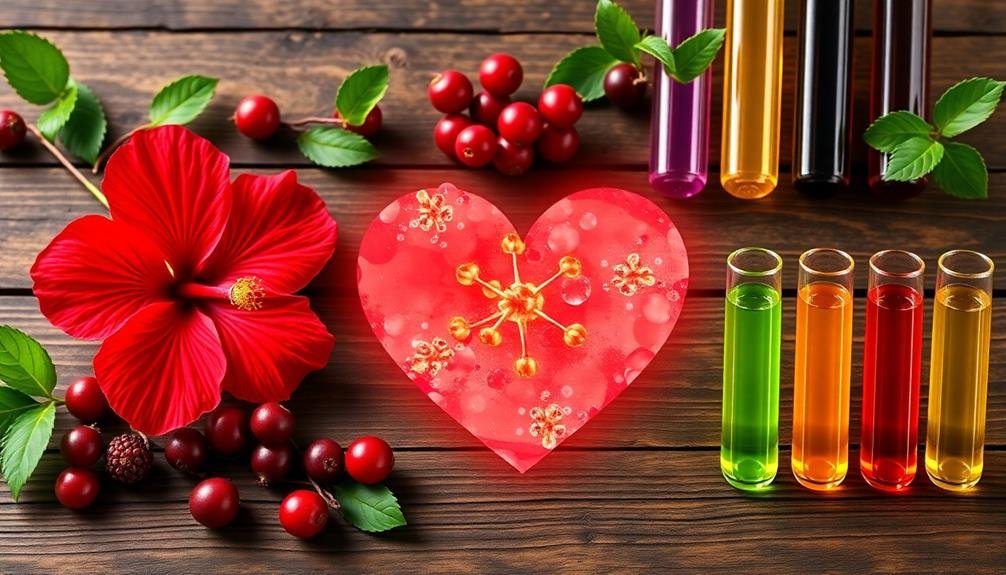
You'll find that both hibiscus and hawthorn are potent sources of antioxidants, which play an essential role in neutralizing harmful free radicals in your body.
These antioxidants help prevent cellular damage that can lead to various heart-related issues and other health problems.
Free Radical Neutralization
Releasing their antioxidant prowess, hibiscus and hawthorn safeguard your heart against harmful free radicals. These unstable molecules can damage your cells and contribute to cardiovascular diseases. By neutralizing free radicals, hibiscus and hawthorn help maintain your heart's health and function.
Hibiscus contains powerful antioxidants like anthocyanins and polyphenols. These compounds actively scavenge free radicals, preventing oxidative stress in your cardiovascular system. They protect your blood vessels from damage and reduce inflammation, which can lead to atherosclerosis.
Hawthorn's antioxidant properties stem from its flavonoids and procyanidins. These compounds not only neutralize free radicals but also enhance your body's natural antioxidant defenses. They boost the production of enzymes like superoxide dismutase and catalase, which further combat oxidative stress.
When you combine hibiscus and hawthorn, you're creating a potent antioxidant blend. This synergy amplifies their free radical neutralizing effects, providing enhanced protection for your heart.
Regular consumption of this blend can help prevent oxidative damage, reduce the risk of heart disease, and promote overall cardiovascular health. By incorporating these herbs into your diet, you're taking a proactive step towards maintaining a healthy heart.
Cellular Damage Prevention
The antioxidant power of hibiscus and hawthorn extends beyond free radical neutralization, offering robust cellular damage prevention.
These botanical allies work synergistically to protect your heart's cells from oxidative stress, which can lead to premature aging and dysfunction. By fortifying cell membranes and preserving DNA integrity, hibiscus and hawthorn help maintain your cardiovascular system's overall health and longevity.
When you consume hibiscus and hawthorn together, you're providing your body with a powerful defense against cellular damage.
Here's how this blend safeguards your heart's cells:
- Strengthens cell membranes, making them more resistant to oxidative attacks
- Protects mitochondria, the cell's powerhouses, ensuring efficient energy production
- Prevents lipid peroxidation, which can lead to arterial plaque formation
- Supports DNA repair mechanisms, reducing the risk of genetic mutations
This cellular protection is vital for maintaining a healthy heart.
Blood Pressure Regulation

Over the years, research has shown that both hibiscus and hawthorn can play significant roles in regulating blood pressure. Hibiscus, particularly Hibiscus sabdariffa, has been found to have antihypertensive properties. It works by inhibiting angiotensin-converting enzyme (ACE), which helps relax blood vessels and reduce blood pressure.
Studies have demonstrated that regular consumption of hibiscus tea can lead to notable decreases in both systolic and diastolic blood pressure.
Hawthorn, on the other hand, acts as a natural beta-blocker. It helps dilate blood vessels, improve blood flow, and reduce the workload on your heart. This herb contains procyanidins and flavonoids that contribute to its blood pressure-lowering effects.
Research indicates that hawthorn can modestly reduce diastolic blood pressure and may be particularly beneficial for those with mild hypertension.
When you combine hibiscus and hawthorn, you're leveraging their complementary mechanisms to support healthy blood pressure levels. This synergistic blend can provide a natural approach to maintaining cardiovascular health.
However, it's essential to consult with your healthcare provider before using these herbs, especially if you're on blood pressure medications, to avoid potential interactions or complications.
Cholesterol Management
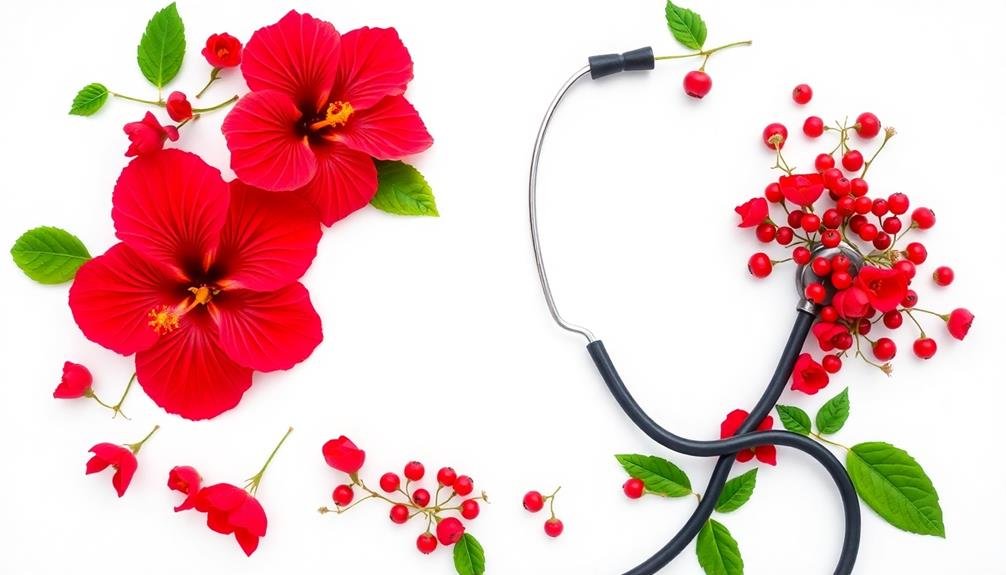
Cholesterol, a waxy substance found in your blood, plays an essential role in heart health. However, when levels become imbalanced, it can lead to serious cardiovascular issues.
Hawthorn and hibiscus work together to help manage your cholesterol levels effectively.
Hawthorn contains compounds that may help lower LDL (bad) cholesterol while increasing HDL (good) cholesterol. It's believed to enhance the body's ability to process and eliminate excess cholesterol.
Hibiscus, on the other hand, has been shown to reduce total cholesterol and triglyceride levels in some studies.
When you combine these two powerful herbs, you're giving your body a natural boost in cholesterol management.
Here's what you might experience:
- Decreased LDL cholesterol levels
- Increased HDL cholesterol levels
- Reduced total cholesterol
- Lowered triglyceride levels
Flavor Profile
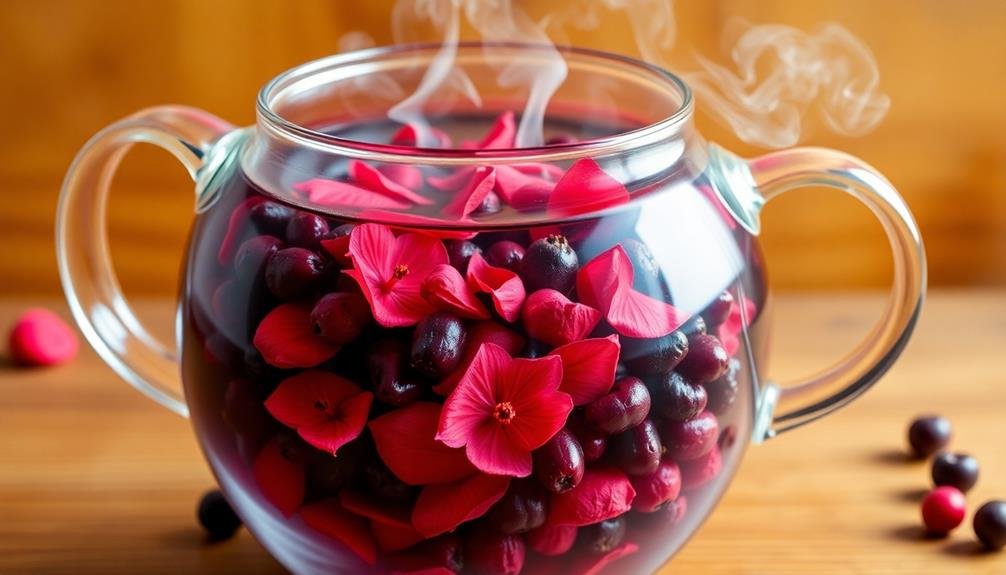
You'll discover that hibiscus and hawthorn offer unique and complementary flavor profiles.
Hibiscus brings a tangy, almost cranberry-like taste with subtle floral undertones, while hawthorn contributes a milder, slightly sweet flavor.
These distinct tastes blend well in teas and other beverages, creating a balanced and enjoyable drinking experience that supports your heart health.
Tangy and Floral Notes
A burst of flavor awaits those who sip hibiscus and hawthorn tea. The blend offers a unique combination of tangy and floral notes that'll dance on your taste buds. Hibiscus brings a tart, cranberry-like flavor with subtle sweetness, while hawthorn adds a mild, earthy undertone with hints of apple.
As you savor this heart-healthy brew, you'll notice:
- A vibrant red hue that's as appealing to the eye as it's to the palate
- An initial zing of acidity that awakens your senses
- A delicate floral aroma that wafts up from your cup
- A smooth finish that leaves a pleasant, slightly sweet aftertaste
The tangy notes of hibiscus dominate the flavor profile, but they're beautifully balanced by the more subtle hawthorn. This combination creates an invigorating and complex taste that's both stimulating and soothing.
You'll find the tea equally enjoyable hot or iced, making it a versatile addition to your daily routine. The natural tartness also means you can enjoy this blend without added sweeteners, though a touch of honey can complement the flavors if you prefer.
Complementary Taste Profiles
The complementary taste profiles of hibiscus and hawthorn create a harmonious blend that's greater than the sum of its parts. When you combine these two herbs, you'll experience a complex flavor that balances tartness with subtle sweetness.
Hibiscus brings a bold, cranberry-like acidity to the mix, with deep floral notes and an invigorating finish. It's this vibrant tartness that forms the backbone of the blend.
Hawthorn, on the other hand, offers a milder, slightly sweet taste with hints of apple and a gentle earthy undertone. This softer flavor helps to round out the sharpness of hibiscus, creating a more balanced and nuanced profile.
As you sip this blend, you'll notice how the flavors evolve. The initial burst of hibiscus gives way to the mellow notes of hawthorn, creating a layered taste experience.
The combination also enhances the natural astringency of both herbs, leaving a clean, slightly dry sensation on your palate. This blend isn't just about taste, though. The complementary flavor profiles make it easier and more enjoyable to consume these heart-healthy herbs regularly, potentially increasing their beneficial effects on your cardiovascular system.
Brewing Methods

Brewing methods for hibiscus and hawthorn teas are simple and versatile. You can prepare these heart-healthy herbs separately or combine them for a synergistic blend.
Hot infusion is the most common technique, steeping the dried flowers or berries in boiling water for 5-10 minutes. For a stronger brew, increase the steeping time or use more plant material.
Cold brewing is an excellent option for a revitalizing summer drink. Simply add the herbs to room temperature water and refrigerate for 4-8 hours. This method results in a smoother, less bitter flavor profile.
For a more potent preparation, you can create a decoction by simmering the herbs in water for 15-20 minutes. This method is particularly useful for extracting beneficial compounds from hawthorn berries.
Here's a quick guide to brewing your hibiscus-hawthorn tea:
- Measure 1-2 teaspoons of dried herbs per cup of water
- Pour hot water over the herbs in a teapot or mug
- Cover and steep for 5-10 minutes
- Strain and enjoy, adding honey or lemon to taste
Experiment with these methods to find your preferred brewing technique and strength. You'll soon discover the perfect balance for your heart-healthy hibiscus and hawthorn blend.
Dosage Recommendations
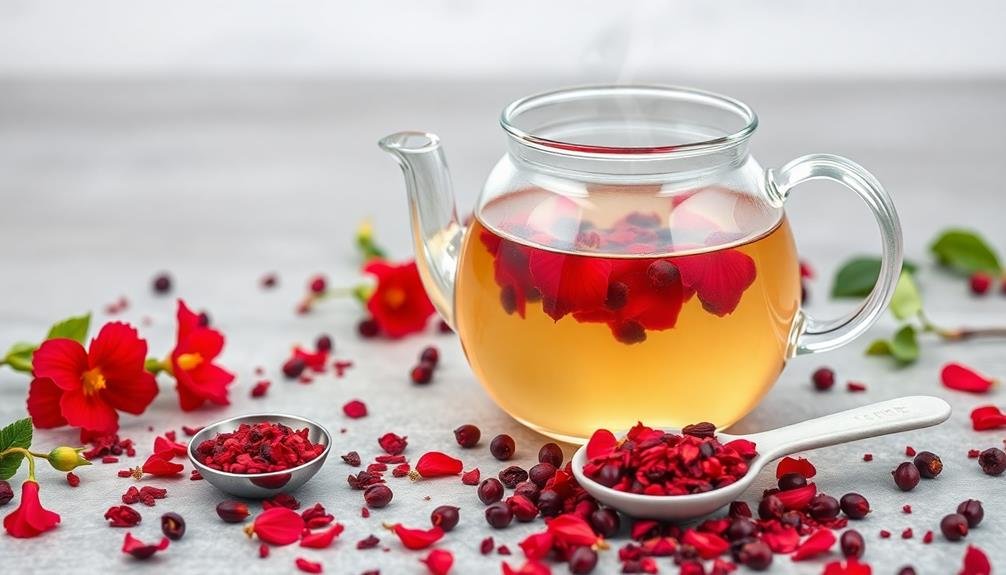
While brewing methods are important, understanding proper dosage is key to maximizing the benefits of hibiscus and hawthorn for heart health. You'll want to start with a lower dose and gradually increase it to find your ideal amount. For hibiscus tea, aim for 1-3 cups daily, using 1-2 teaspoons of dried hibiscus flowers per cup. With hawthorn, a typical dose is 250-500mg of standardized extract, taken 2-3 times daily.
Here's a quick reference guide for dosage recommendations:
| Form | Hibiscus | Hawthorn | Combined |
|---|---|---|---|
| Tea | 1-3 cups/day | 1-2 cups/day | 2-3 cups/day |
| Capsules | 400-600mg/day | 500-1500mg/day | 300-900mg/day |
| Tincture | 2-4ml, 3x/day | 1-2ml, 3x/day | 1-3ml, 3x/day |
| Powder | 1-2 tsp/day | 1-2 tsp/day | 1-1.5 tsp/day |
| Extract | 100-200mg/day | 250-500mg, 2-3x/day | 150-300mg, 2x/day |
Potential Side Effects
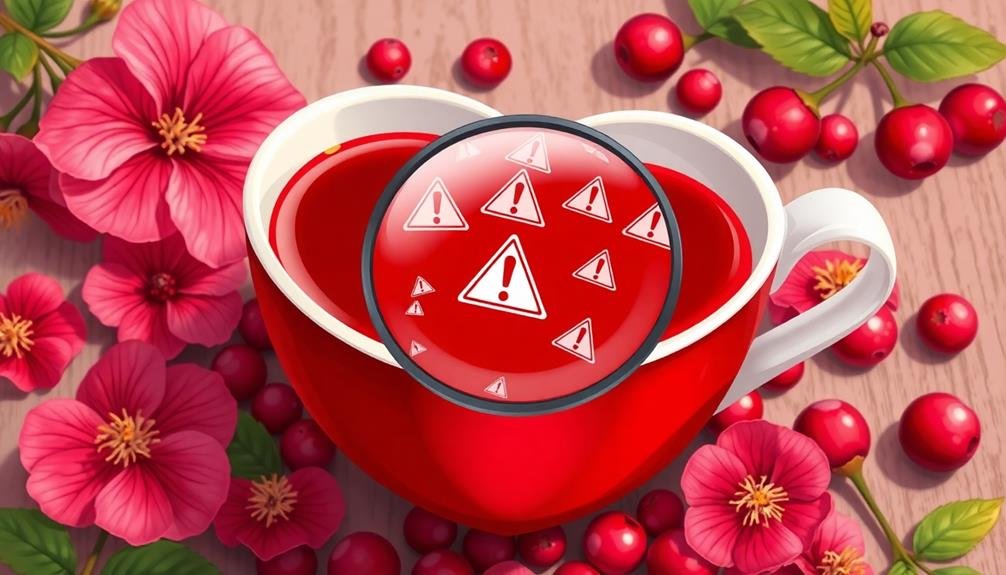
Despite the benefits of hibiscus and hawthorn for heart health, you should be aware of potential side effects. While generally safe for most people, these herbs can interact with certain medications or cause adverse reactions in some individuals.
Hibiscus may lower blood pressure, so if you're already taking blood pressure medication, it could cause your levels to drop too low. It can also affect estrogen levels, so pregnant women should avoid it.
Hawthorn can interact with heart medications, potentially enhancing their effects or causing unwanted side effects.
Here are four potential side effects to watch for when using hibiscus and hawthorn:
- Dizziness or lightheadedness
- Nausea or upset stomach
- Headaches
- Irregular heartbeat
If you experience any of these symptoms, stop using the herbs and consult your healthcare provider.
It's important to inform your doctor about any herbal supplements you're taking, especially if you have existing health conditions or are on medication. While hibiscus and hawthorn can offer heart health benefits, it's vital to use them responsibly and under proper guidance.
Complementary Herbs
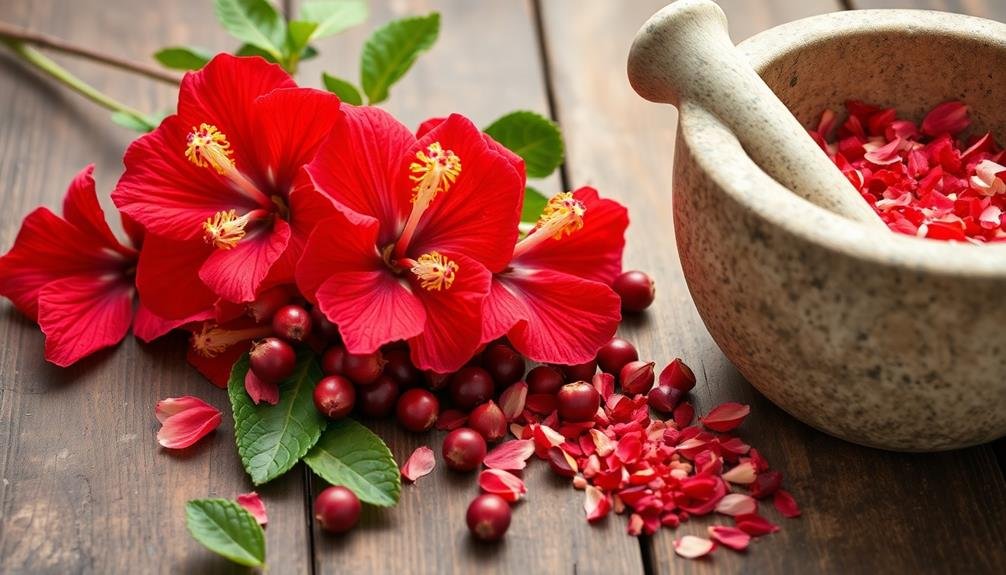
You'll find that hibiscus and hawthorn aren't the only herbs that support heart health.
When combined with other cardio-friendly herbs, you can experience enhanced benefits through synergistic effects.
Consider exploring herbs like garlic, ginger, or motherwort to amplify the heart-protective properties of hibiscus and hawthorn in your wellness routine.
Synergistic Herbal Effects
Combining hibiscus and hawthorn can pack a powerful punch for heart health. These two herbs work synergistically, enhancing each other's beneficial effects on your cardiovascular system.
When you blend them, you're not just getting the sum of their individual benefits; you're revealing a potent herbal duo that can support your heart in multiple ways.
The synergistic effects of hibiscus and hawthorn include:
- Enhanced blood pressure regulation
- Improved cholesterol management
- Strengthened antioxidant protection
- Increased overall cardiovascular function
By taking these herbs together, you're leveraging their complementary properties. Hibiscus helps relax blood vessels and reduce inflammation, while hawthorn strengthens heart muscle and improves blood flow.
This combination can lead to better heart health outcomes than using either herb alone.
Amplifying Heart Benefits
While hibiscus and hawthorn form a powerful duo, their heart-boosting effects can be further enhanced by incorporating other complementary herbs.
You'll find that adding garlic to your hibiscus-hawthorn blend can considerably amplify its cardiovascular benefits. Garlic's ability to lower blood pressure and reduce cholesterol levels complements the vasodilating effects of hibiscus and hawthorn.
Another herb to weigh is ginger. It's known for its anti-inflammatory properties and can improve circulation, working synergistically with hibiscus and hawthorn to promote overall heart health.
Ginkgo biloba is also an excellent addition, as it enhances blood flow and protects against oxidative stress.
Don't overlook the potential of motherwort. This herb can help regulate heart rhythm and reduce anxiety, which often accompanies heart issues. Combining it with hibiscus and hawthorn creates a thorough approach to heart health.
Lastly, think about adding lemon balm to your herbal blend. Its calming effects can help reduce stress-induced heart palpitations, while its antioxidant properties support the cardioprotective effects of hibiscus and hawthorn.
Historical Uses
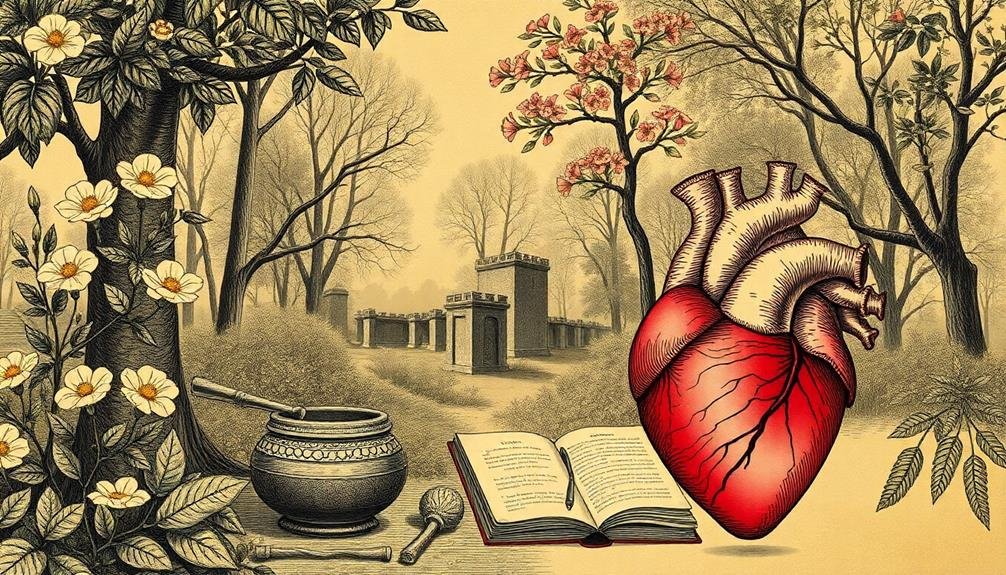
The historical uses of hibiscus and hawthorn stretch back centuries across various cultures. You'll find that both plants have been revered for their medicinal properties, particularly in traditional medicine systems.
Hibiscus has been a staple in Egyptian, African, and Middle Eastern cultures. It's been used to treat high blood pressure, liver disorders, and fevers. In ancient Egypt, pharaohs would drink hibiscus tea to cool down in the scorching heat.
Meanwhile, hawthorn has deep roots in European and Chinese herbalism. It's been traditionally used to strengthen the heart, improve circulation, and calm anxiety.
Here's a glimpse into the historical uses of these plants:
- Ancient Egyptians used hibiscus to lower body temperature and treat heart and nerve diseases.
- Native Americans used hawthorn berries to treat heart troubles and digestive issues.
- Traditional Chinese Medicine employed hawthorn to aid digestion and improve blood flow.
- European herbalists prescribed hawthorn for heart palpitations and shortness of breath.
Today, modern research is validating many of these traditional uses, particularly in the field of cardiovascular health. You're benefiting from centuries of wisdom when you combine these two powerful herbs for heart health.
Scientific Research
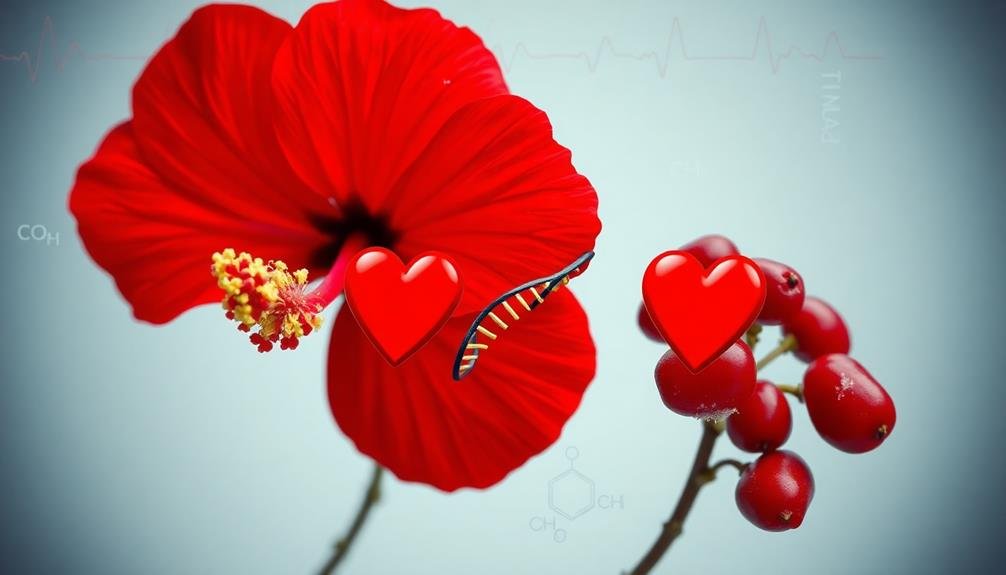
Recent scientific studies have shed light on the heart-health benefits of hibiscus and hawthorn. Research has shown that hibiscus can help lower blood pressure and reduce the risk of hypertension.
It's rich in antioxidants, particularly anthocyanins, which protect your heart from oxidative stress. Studies have found that consuming hibiscus tea regularly may decrease both systolic and diastolic blood pressure.
Hawthorn, on the other hand, has been extensively studied for its potential to improve heart function. It's been shown to increase the heart's pumping ability and reduce symptoms of congestive heart failure.
Research indicates that hawthorn can widen blood vessels, improving circulation and reducing the strain on your heart. It may also help lower cholesterol levels and reduce the risk of atherosclerosis.
When combined, hibiscus and hawthorn create a powerful synergy. Their complementary effects on blood pressure, circulation, and heart function make them an ideal blend for cardiovascular health.
While more research is needed to fully understand their combined impact, existing studies suggest that this herbal duo could be a valuable addition to heart-healthy lifestyles.
Incorporating Into Daily Routine

Incorporating hibiscus and hawthorn into your daily routine doesn't have to be complicated. These heart-healthy herbs can be easily consumed in various forms, making it simple to reap their benefits. You can start by brewing a soothing cup of hibiscus tea in the morning or enjoying a revitalizing glass of iced hawthorn berry tea in the afternoon.
For those who prefer supplements, hawthorn extract capsules are readily available and can be taken with meals.
To make the most of these herbs, consider:
- Making a large batch of hibiscus-hawthorn iced tea to keep in your fridge for easy access throughout the week.
- Adding dried hibiscus flowers or hawthorn berries to your morning smoothie for an antioxidant boost.
- Incorporating hawthorn powder into your baking recipes, such as muffins or energy bars.
- Creating a relaxing evening ritual by sipping on a warm blend of hibiscus and hawthorn tea before bed.
Remember to consult with your healthcare provider before adding these herbs to your routine, especially if you're taking medications or have existing health conditions.
Start with small amounts and gradually increase to find the right balance for your body.
Frequently Asked Questions
Can Pregnant Women Safely Consume Hibiscus and Hawthorn Blend?
You shouldn't consume hibiscus and hawthorn blend during pregnancy. It's best to avoid these herbs as they may affect blood pressure and uterine contractions. Always consult your healthcare provider before taking any herbal supplements while pregnant.
How Long Does It Take to See Benefits From Drinking This Blend?
You'll typically notice benefits from drinking hibiscus and hawthorn blend within 2-4 weeks. However, it's important to maintain consistent consumption. Remember, individual results may vary, and you should consult your doctor for personalized advice on heart health.
Are There Any Known Drug Interactions With Hibiscus and Hawthorn Blend?
You should be cautious about drug interactions with hibiscus and hawthorn. They can affect blood pressure and blood thinning medications. It's essential to consult your doctor before using this blend, especially if you're on heart medications.
Can Children Drink Hibiscus and Hawthorn Tea for Heart Health?
You shouldn't give children hibiscus and hawthorn tea for heart health. It's not recommended for kids due to potential side effects. Always consult a pediatrician before giving any herbal remedies to children, as they're not well-studied in young populations.
Is the Blend Effective for Treating Specific Heart Conditions Like Arrhythmia?
While hibiscus and hawthorn blend may support heart health, it's not proven to treat specific conditions like arrhythmia. You shouldn't rely on it as a sole treatment. Always consult your doctor for proper diagnosis and management of heart issues.
In Summary
You've discovered a powerful duo for heart health in hibiscus and hawthorn. By blending these herbs, you're tapping into their synergistic effects, boosting antioxidant power, and supporting blood pressure regulation. Don't forget to take into account other complementary herbs too. While historical uses are intriguing, it's the scientific research that really backs up their benefits. Start small and gradually incorporate this blend into your daily routine for ideal heart health support.

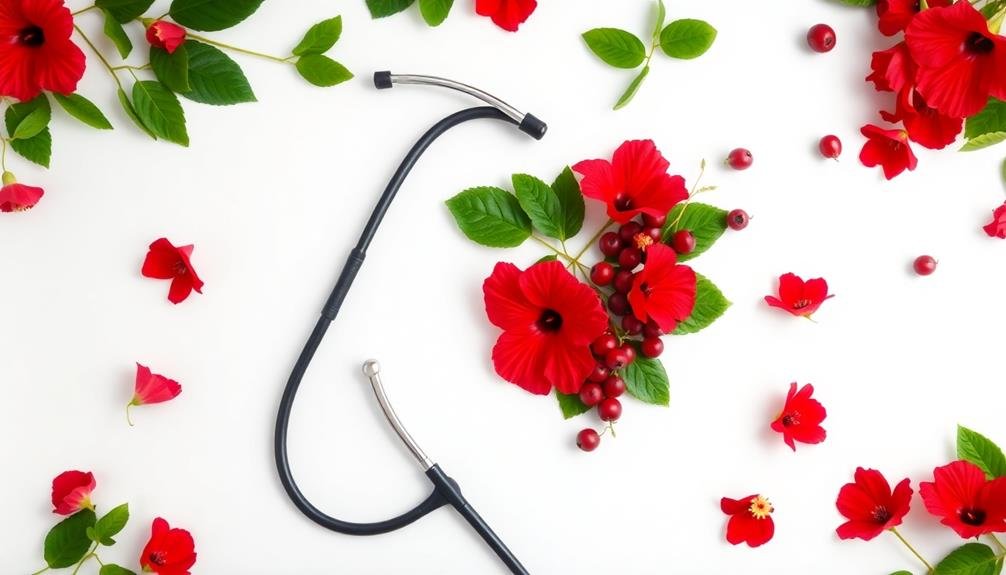
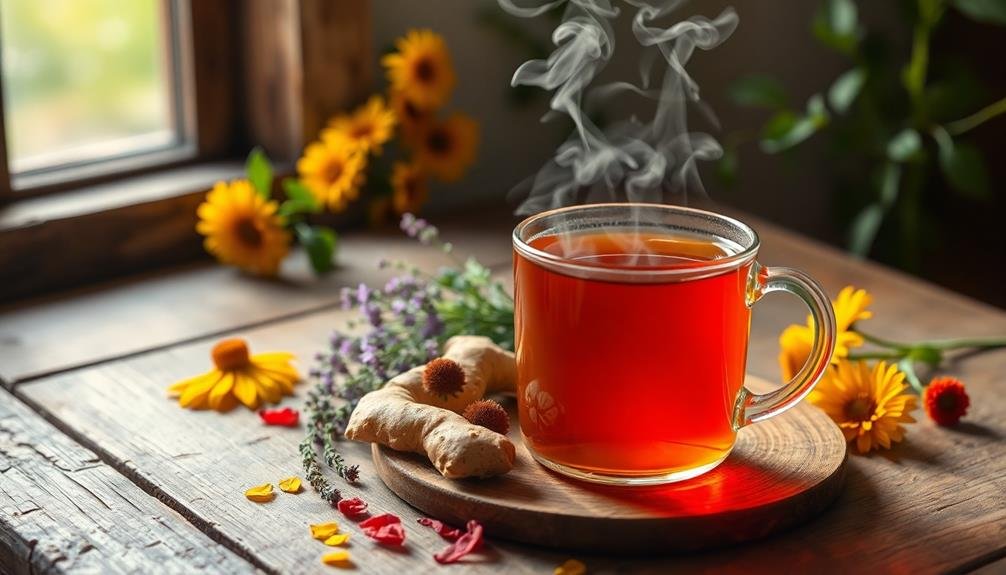
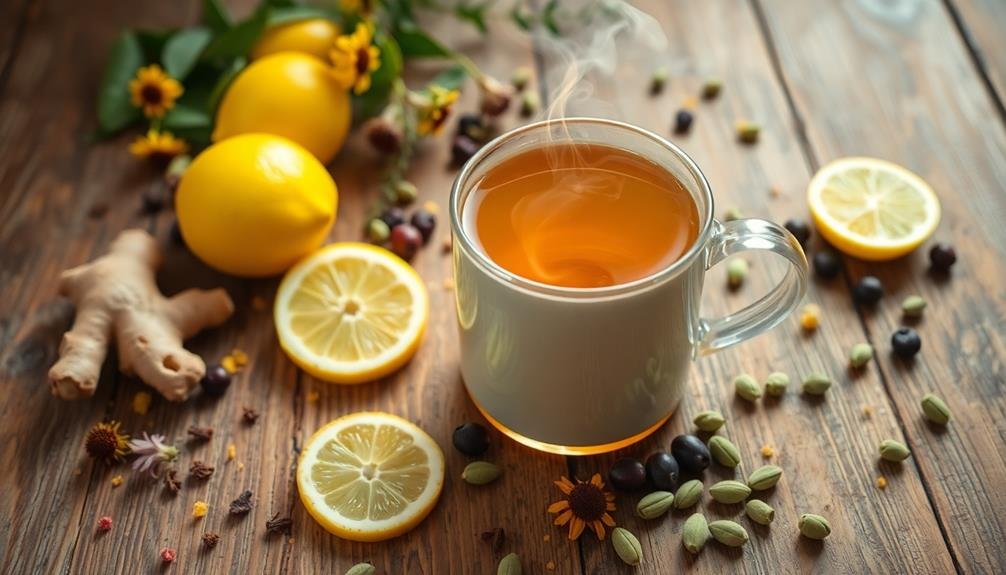
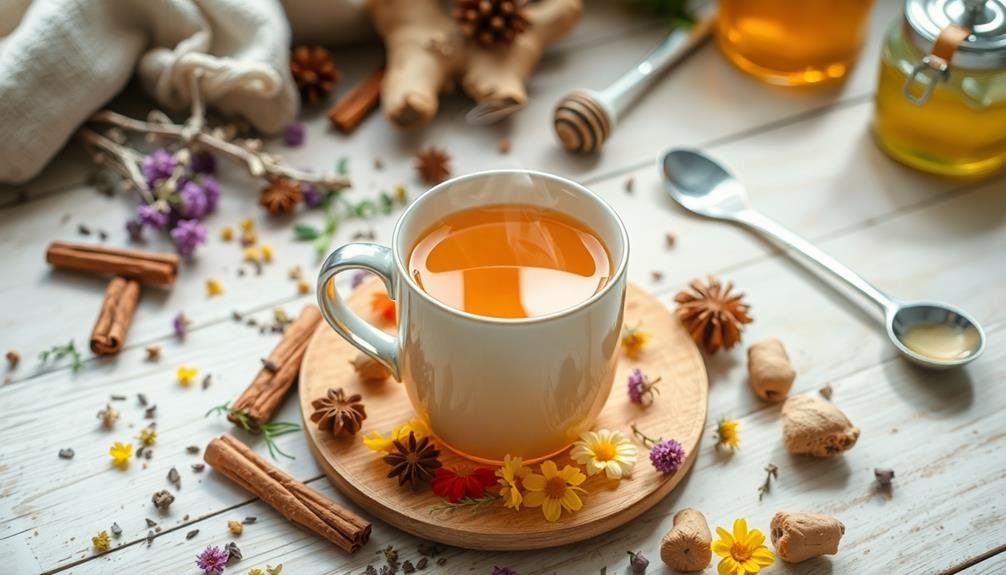
Leave a Reply